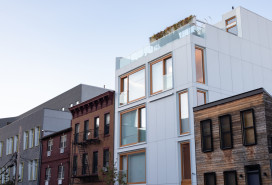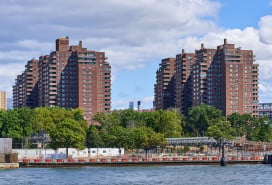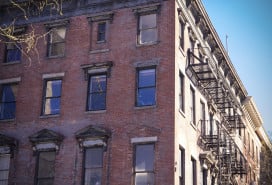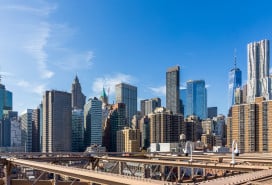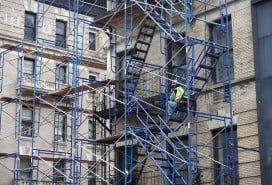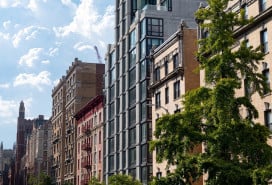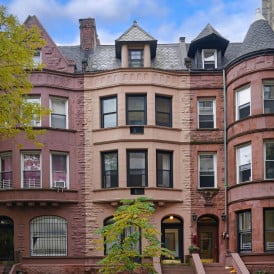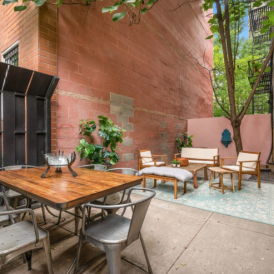Why I left the East Village for Bed-Stuy

Seven years ago this August, I found myself alone for the first time in my New York City apartment, supine on a bare IKEA mattress. I was listening to the wailing sirens and rumbling traffic on First Avenue and marveling at the fact I had made it here in one piece. I was a bona fide resident of the East Village! It was 2008, and I knew one thing for certain — I loved being in the neighborhood that the likes of Allen Ginsberg, William S. Burroughs and Lou Reed once called home, and I never wanted to leave. Honestly, I never thought I would. Yet here I am, writing this in my new apartment in Bedford-Stuyvesant. After seven years, I’ve given up on the place I loved most in New York, and not by choice.
Let me explain: The East Village, as I first knew it, was little disheveled, a little gritty and delightfully weird. Sometimes, it was downright gross. It was Trent from MTV's Daria: a grimy punk slacker with ambiguous ambitions, but still charming in its own way. But definitely not the kind of guy you brought home to introduce to Mom and Dad.
I'd just graduated from college with a creative writing major, and I was in heaven. My neighbors and friends were like the ones I spent my formative college years with, but they dreamed bigger, thought more weirdly, believed anything was possible. And in the East Village, it usually was.
There were a slew of corner bodegas (with the requisite bodega cats), Laundromats, dive bars, and places to grab a cheap slice . If you were really in the red, a $1 slice from Two Brothers would do; if you were flush with cash, it was best to splurge on a $4 slice from Artichoke's. I’d spend my free days wandering around the community gardens or Tompkins Square Park, avoiding the weirdos and kamikaze pigeons to watch impromptu puppet shows and indie movies al fresco or going to the Bowery Poetry Club for readings and once, a male beauty pageant.
I can’t say that I loved my first apartment, with its lilting carpeted floors, comically-small kitchen with micro-fridge, and closet that held exactly three pieces of clothing at any given time. It always smelled kind of moldy (I blame the dubious-looking grey carpet) and I could only shower for a few minutes before the hot water gave out, but I loved what it, and the East Village, represented. The work-your-day-job-then-stay-up-until-dawn attitude. It was a bohemian hangover. My friends and I still had to work in whitewashed Midtown, but we came home to a place bursting with creative energy. And when I looked through the rusted wrought iron gates of my window at night, I could just see the Empire State building with its glowing lights (this was before they were LED, mind you). This was the promise, this was New York City!
A year later, and my next apartment was somewhat of an improvement. I moved in with two college friends to a place on East 7th and First Avenue, a stone’s throw away from cupcake mecca Butter Lane (shown below) and Xoom, my favorite smoothie place that would one day become Big Gay Ice Cream (also tasty, but I prefer peanut butter banana smoothies to Salty Pimps).

It was in the middle of the recession, so we scored a gut-renovated three bedroom for $3,000 a month (now renting for $3,700). "Three-bedroom" was a very generous description, since my room was the size of a dank, lightless walk-in closet. But it was the East Village, and I was determined to stay as long as humanly possible, meaning I sold all of my bulky IKEA furniture, got rid of 80 percent of my worldly belongings, and lived the next two years of my life like a refugee, if that refugee were shelling out $900 a month. Somehow, I made 48 square feet of personal space work, but since there was so much to do and see in my corner of the city, it hardly mattered.
Then it was onto a tenement on St. Mark’s and First Avenue, after I decided to move in with my boyfriend. In the span of a few brief years, much had already changed. The gutter-punk kids were surrendering their spot an avenue west, replaced by Murray Hill residents clamoring for Pinkberry and Chipotle. These new imports were endlessly thirsty for the next happy hour or “new” experience, leaving the smell of expensive cologne and trails of vomit in their wake (no joke).
But life went on as usual, and I was quite happy in our one-bedroom tenement. It had all the charm I'd hoped for (bright sun, decent space, a marble fireplace, and original flooring, all overlooking a rooftop garden), and some extra quirk (no sink in the bathroom, a tuberculosis window that looked in from the kitchen to the bedroom). The rent was decent for the amount of space we had, and so we carried on blissfully for our first year.
Then — plenty of unsavory changes. An architectural monstrosity replaced a single-story coffee shop, bringing with it big international companies like IBM Watson, law firms, and the Daily Mail, where I used to work. Suddenly, quasi-bohemian St. Mark’s turned aggressively into bro-hemia. Bars were suddenly filled with suits looking to down some awesome shots. Rents skyrocked, shuttering neighborhood staples like St. Mark's Books and 8 Bits and Up. And, being three blocks away from the office tower, my own rent skyrocketed, too.
It would be unfair for me to blame my newfound distaste for the East Village on a single building, or the fact that my neighborhood wasn’t immune to rapid and often alienating changes overwhelming the rest of the city. Small businesses go out, and banks and Duane Reades come in. Out-of-towners swarm the bars on weekends, and tour busses rumble down 1st Ave packed with gawkers. The avenues now glow, not with signs for bars, but for TD Bank, Chase, and Bank of America, and more frozen yogurt shops than George Costanza would know what to do with. There are even luxury condos across from the Jacob Riis housing projects on Avenue D — noted by the almost comical “The Hunt” from last year.
You could argue that I was a gentrifier myself. And maybe I was. But I did my best to shop local, buying my burritos not from Chipotle but exclusively from Downtown Bakery II, where the guac didn’t cost $2 a cup. I frequented readings and plays in the area and did my part to support other community efforts, but in the end, I'm not sure if it was enough. I'm not even sure if any New York neighborhood can save itself from what seems like the inevitable quest for more luxury condos and a whitewashed city full of banks and chain stores.
I mourn the forever-lost neighborhood staples. The little First Avenue music shop, De Robertis Pastry, Kim’s Video especially. All have boarded up to make way for bright, shiny, small-batch candy stores and artisanal locavore fare. The store that replaced Kim’s is, in fact, an artisanal market selling high-end produce and cold-pressed juices.
My own journey in the East Village was much the same. I came in at the tail-end of its scrappy punk-and-art days, able to see the last vestiges of what it once was. But, like Kim’s, I eventually buckled under the immense financial burden of skyrocketing rents and shifting demographics. I couldn’t justify paying so much for a tenement that, only three years ago, cost $500 less a month.
To borrow a well-known phrase from my well-known neighbor, Jimmy McMillan, the rent was just too damn high. And I had to ask myself: What made it worth living in the East Village anymore? I was hardly home because of a demanding job that I needed to pay my part of the rent, and when I was home, I was too exhausted to do anything besides order dinner on Seamless and pass out, dreading the next day. It was nice to be able to meander around the city, but on weekends, the streets were all but overrun with visitors on yet another sanitized tour or the Weekend Brunch Warriors stodgily blocking all traffic flow on the sidewalks, making leisurely strolls all but impossible.
On a hazy day in March, my boyfriend and I were both home when, to our shock, we heard an almighty blast and felt our apartment quake. We would later find out about the gas explosion on Second Avenue that claimed the lives of two people and caused three historic buildings to collapse. Turns out, there will likely be a criminal investigation of the building owner and the contractor, both of whom are suspected of allegedly illegally tapping into a gas main. Months later, a chain link fence blocked off the gravel lot where the buildings once stood. Signs to the two victims were pinned to the fence, along with a paper saying, "This was a preventable tragedy caused by greed and illegal practices all too common in the city."
Greed. There it was plain as day.
Do I think the East Village dead? Of course not. But it's time to say goodbye to all that, whatever this new incarnation now is. True, there are probably many people who would say I've simply left one neighborhood to gentrify another. Maybe I have, but what other choice was there if I wanted to stay in the city? Someone will always be displaced or priced out. It happened to me in the East Village, as it has happened to countless others.
As The Atlantic argued out last year, there's basically no way not to be a gentrifier, even if you try your hardest to avoid becoming one. As someone who wasn't born and raised in New York, I'll always be something of an outlier, but I'm trying to take my East Village ethos and apply it here to Bed-Stuy — saying hello to my neighbors, separating my recyclables, frequenting local bodegas and restaurants, and basically not treating Bed-Stuy as some extension of my old Manhattan haunts. This neighborhood is diverse, rich in culture, and full of pride, and I'm learning to love it for what it is, not trying to make it fit into a mold of what I might hope it will be. It's sort of like being in a relationship. You don't try to change your partner, you embrace them for who they are. You grow together.
On the street where I now live, many of the brownstones have been in the same families for generations, and everyone identifies each other by street address. "Oh, hello, I'm Mike from 601," and so on. There is space to breathe, spectacular stoop gardens, great food and not a bro or Duane Reade in sight.
Related:
Why I'm leaving Bed-Stuy for good
Sorry, Taylor Swift: These 8 songs really capture the magic and mayhem of living in NYC

